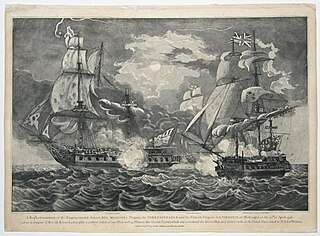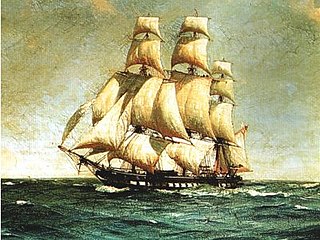
The Siege of Alexandria was fought during the French Revolutionary Wars between French and British forces. It was the last action of the French campaign in Egypt and Syria (1798–1801). The French had occupied Alexandria, a major fortified harbour city on the Nile Delta in northern Egypt, since 2 July 1798, and the garrison there surrendered on 2 September 1801.

The Téméraire-class ships of the line were a class of a hundred and twenty 74-gun ships of the line ordered between 1782 and 1813 for the French navy or its attached navies in dependent (French-occupied) territories. Although a few of these were cancelled, the type was and remains the most numerous class of capital ship ever built to a single design.
HMS Meleager was a 32-gun Amazon-class frigate' that Greaves and Nickolson built in 1785 at the Quarry House yard in Frindsbury, Kent, England. She served during the French Revolutionary Wars until 1801, when she was wrecked in the Gulf of Mexico.

The Virginie class was a class of ten 40-gun frigates of the French Navy, designed in 1793 by Jacques-Noël Sané. An eleventh vessel (Zephyr) begun in 1794 was never completed.

Engageante was a 26-gun frigate of the French Navy, only ship of her class, built to a design by Jean-François Etienne. The British captured her in 1794 and converted her to a hospital ship. She served as a hospital ship until she was broken up in 1811.

Égyptienne was a French frigate launched at Toulon in 1799. Her first service was in Napoleon's Egyptian campaign of 1801, in which the British captured her at Alexandria. She famously carried the Rosetta Stone to Woolwich, and then the Admiralty commissioned her into the Royal Navy as the 40-gun fifth-rate frigate HMS Egyptienne. She served in a number of single-ship actions before being reduced to harbour service in 1807, and was sold for breaking in 1817.

Régénérée was a 40-gun Cocarde-class frigate of the French Navy. The British captured her in 1801 at the fall of Alexandria, named her HMS Alexandria, sailed her back to Britain, but never commissioned her. She was broken up in 1804.
The Capitulation of Alexandria in August 1801 brought to an end the French expedition to Egypt.

Alceste was a Magicienne class frigate of the French Navy, launched in 1780, that the British seized at the Siege of Toulon. They transferred her to the Kingdom of Sardinia, but the French recaptured her a year later in the action of 8 June 1794. The British captured her again at the action of 18 June 1799 and took her into service as HMS Alceste. In 1801 she became a floating battery and she was sold the next year.
During the French Revolutionary and Napoleonic Wars Égyptienne, or Egypt, which commemorated Napoleon's Egyptian Campaign, was a popular name for French vessels, including naval vessels and privateers. Between 1799 and 1804, warships of the Royal Navy captured one French frigate and five different French privateers all with the name Egyptienne, and at least one privateer with the name Egypte.
The French brig Alerte was launched in April 1787. The Royal Navy captured her at Toulon in August 1793, and renamed her HMS Vigilante. The British set her on fire when they evacuated Toulon in December of that year. After the French rebuilt her as Alerte, she served at the Battle of Aboukir Bay. The British recaptured her in June 1799 and took her into service as HMS Minorca. Minorca was sold in 1802.

The Forte class was a class of two large frigates of the French Navy, designed in 1794 by François Caro. They carried 30 24-pounder long guns as their main battery and 20 x 8 pdrs on the quarterdeck and forecastle; they were exceptionally large and powerful heavy frigates for their time.
Cérès was an 18-gun Etna-class corvette of the French Navy, launched in 1795. Begun in 1794 as Courageuse, the corvette was renamed Cérès in May 1795 and launched the same month. In 1797, she was again renamed, as Enfant de la Patrie. She was wrecked on the shores of Norway on 17 February 1798.
Courageuse was a 12-pounder Concorde class frigate of the French Navy. She was launched in 1778. The British captured her in 1799 and thereafter used her as a receiving ship or prison hulk at Malta before breaking her up in 1802.
The action of 18 June 1799 was a naval engagement of the French Revolutionary Wars fought off Toulon in the wake of the Mediterranean campaign of 1798. A frigate squadron under Rear-admiral Perrée, returning to Toulon from Syria, met a 30-ship British fleet under Lord Keith. Three ships of the line and two frigates detached from the British squadron, and a 28-hour running battle ensued. When the British ships overhauled them, the French frigates and brigs had no choice but to surrender, given their opponents' overwhelming strength.
Salamine was originally the Spanish Navy's Infante 18-gun brig, built in 1787 at Cadiz. The French Navy captured her at Toulon in December 1793 and recommissioned her; they renamed her on 10 May 1798 as Salamine, for the battle of Salamis. On 18 June 1799, HMS Emerald captured her and she was brought into Royal Navy service as HMS Salamine. She served briefly in the Mediterranean, where she captured two French privateers and several merchant vessels before the Royal Navy sold her at Malta in 1802, after the Treaty of Amiens ended the war with France.
Brune was a Coquette class 20-gun corvette of the French Navy, launched in 1781 and captured in 1799 at the siege of Corfu, which saw a joint Russian and Turkish fleet capture Corfu from an occupying French force.

HMS Romulus was a 36-gun fifth rate frigate of the Royal Navy. At the outbreak of the French Revolutionary Wars, Romulus was despatched to the Mediterranean where she became part of the fleet under Lord Hood, initially blockading, and later occupying, the port of Toulon. She played an active role during the withdrawal in December, providing covering fire while HMS Robust and HMS Leviathan removed allied troops from the waterfront.
Cornish Hero first appeared in easily accessible records when Captain John Hartney acquired a letter of marque on 4 March 1797. She had a burthen of 182 tons and a crew of 80 men, indicating that she was a privateer. She carried fourteen 6–pounder guns and eight swivel guns. On 20 March he sailed from Falmouth on a cruise.








